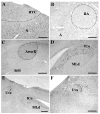Expression of reelin, its receptors and its intracellular signaling protein, Disabled1 in the canary brain: relationships with the song control system
- PMID: 18448255
- PMCID: PMC2836269
- DOI: 10.1016/j.neuroscience.2008.02.020
Expression of reelin, its receptors and its intracellular signaling protein, Disabled1 in the canary brain: relationships with the song control system
Abstract
Songbirds produce learned vocalizations that are controlled by a specialized network of neural structures, the song control system. Several nuclei in this song control system demonstrate a marked degree of adult seasonal plasticity. Nucleus volume varies seasonally based on changes in cell size or spacing, and in the case of nucleus HVC and area X on the incorporation of new neurons. Reelin, a large glycoprotein defective in reeler mice, is assumed to determine the final location of migrating neurons in the developing brain. In mammals, reelin is also expressed in the adult brain but its functions are less well characterized. We investigated the relationships between the expression of reelin and/or its receptors and the dramatic seasonal plasticity in the canary (Serinus canaria) brain. We detected a broad distribution of the reelin protein, its mRNA and the mRNAs encoding for the reelin receptors (VLDLR and ApoER2) as well as for its intracellular signaling protein, Disabled1. These different mRNAs and proteins did not display the same neuroanatomical distribution and were not clearly associated, in an exclusive manner, with telencephalic brain areas that incorporate new neurons in adulthood. Song control nuclei were associated with a particular specialized expression of reelin and its mRNA, with the reelin signal being either denser or lighter in the song nucleus than in the surrounding tissue. The density of reelin-immunoreactive structures did not seem to be affected by 4 weeks of treatment with exogenous testosterone. These observations do not provide conclusive evidence that reelin plays a prominent role in the positioning of new neurons in the adult canary brain but call for additional work on this protein analyzing its expression comparatively during development and in adulthood with a better temporal resolution at critical points in the reproductive cycle when brain plasticity is known to occur.
Figures









Similar articles
-
Effects of testosterone on Reelin expression in the brain of male European starlings.Cell Tissue Res. 2003 Apr;312(1):81-93. doi: 10.1007/s00441-003-0701-9. Epub 2003 Feb 26. Cell Tissue Res. 2003. PMID: 12712319
-
Sex steroid-induced neuroplasticity and behavioral activation in birds.Eur J Neurosci. 2010 Dec;32(12):2116-32. doi: 10.1111/j.1460-9568.2010.07518.x. Eur J Neurosci. 2010. PMID: 21143666 Free PMC article. Review.
-
Interfering of the Reelin/ApoER2/PSD95 Signaling Axis Reactivates Dendritogenesis of Mature Hippocampal Neurons.J Cell Physiol. 2017 May;232(5):1187-1199. doi: 10.1002/jcp.25605. Epub 2016 Oct 25. J Cell Physiol. 2017. PMID: 27653801
-
Disabled1 regulates the intracellular trafficking of reelin receptors.J Biol Chem. 2005 Apr 29;280(17):16901-8. doi: 10.1074/jbc.M409048200. Epub 2005 Feb 17. J Biol Chem. 2005. PMID: 15718228
-
The involvement of Reelin in neurodevelopmental disorders.Neuropharmacology. 2013 May;68:122-35. doi: 10.1016/j.neuropharm.2012.08.015. Epub 2012 Sep 7. Neuropharmacology. 2013. PMID: 22981949 Free PMC article. Review.
Cited by
-
Cell type specializations of the vocal-motor cortex in songbirds.Cell Rep. 2023 Nov 28;42(11):113344. doi: 10.1016/j.celrep.2023.113344. Epub 2023 Oct 30. Cell Rep. 2023. PMID: 37910500 Free PMC article.
-
Wnt modulators in the biotech pipeline.Dev Dyn. 2010 Jan;239(1):102-14. doi: 10.1002/dvdy.22181. Dev Dyn. 2010. PMID: 20014100 Free PMC article. Review.
-
The constitutive differential transcriptome of a brain circuit for vocal learning.BMC Genomics. 2018 Apr 3;19(1):231. doi: 10.1186/s12864-018-4578-0. BMC Genomics. 2018. PMID: 29614959 Free PMC article.
-
Protein-Protein Interaction Among the FoxP Family Members and their Regulation of Two Target Genes, VLDLR and CNTNAP2 in the Zebra Finch Song System.Front Mol Neurosci. 2017 May 1;10:112. doi: 10.3389/fnmol.2017.00112. eCollection 2017. Front Mol Neurosci. 2017. PMID: 28507505 Free PMC article.
-
Molecular microcircuitry underlies functional specification in a basal ganglia circuit dedicated to vocal learning.Neuron. 2012 Feb 9;73(3):537-52. doi: 10.1016/j.neuron.2012.01.005. Neuron. 2012. PMID: 22325205 Free PMC article.
References
-
- Aamodt SM, Kozlowski MR, Nordeen EJ, Nordeen KW. Distribution and developmental change in [3H]MK-801 binding within zebra finch song nuclei. J Neurobiol. 1992;23:997–1005. - PubMed
-
- Absil P, Pinxten R, Balthazart J, Eens M. Effects of testosterone on Reelin expression in the brain of male European starlings. Cell Tissue Res. 2003;312:81–93. - PubMed
-
- Alvarez-Buylla A, Kirn JR. Birth, migration, incorporation, and death of vocal control neurons in adult songbirds. J Neurobiol. 1997;33:585–601. - PubMed
-
- Alvarez-Buylla A, Nottebohm F. Migration of young neurons in adult avian brain. Nature. 1988;335:353–354. - PubMed
Publication types
MeSH terms
Substances
Grants and funding
LinkOut - more resources
Full Text Sources
Miscellaneous

